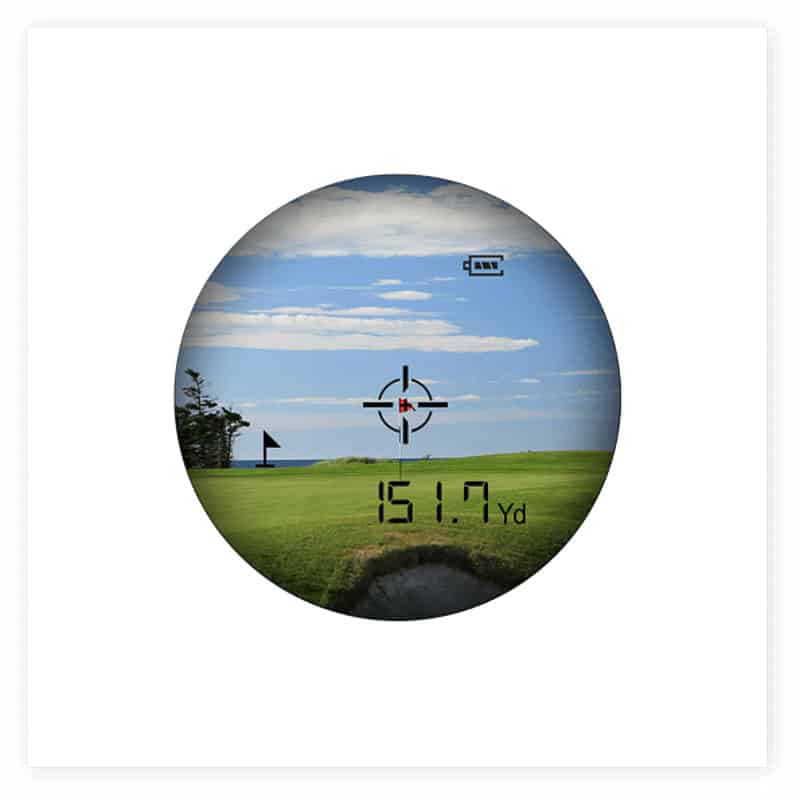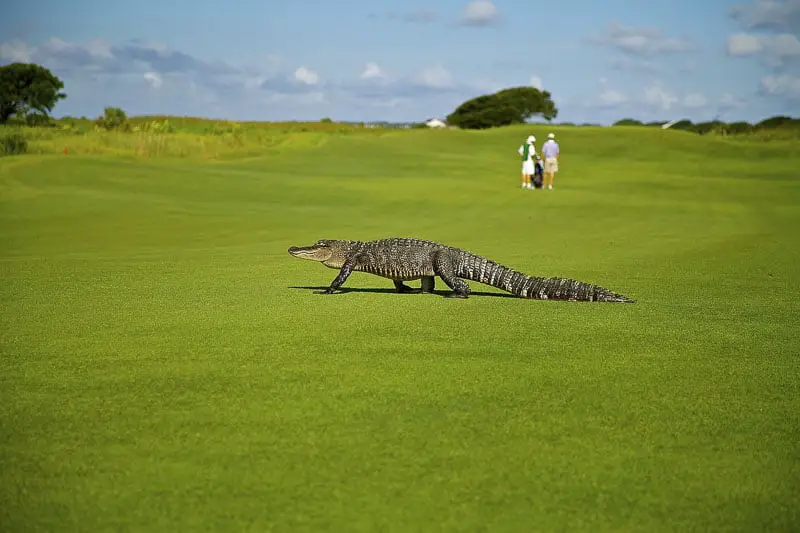No one enjoys going to the golf range and missing all the holes. The golf rangefinder can help newbies, and expert golfers improve their swing. A rangefinder is a tool that will let you know the distance between you and the target. If you are unfamiliar with the rangefinder, you need to know how to use one on the golf course.
How do you use a rangefinder on the golf course? There are a few steps one should take to use a rangefinder on the golf course. You only need to find your target, aim the rangefinder at your target, activate the rangefinder, and get your yardage.
If you are looking to add a rangefinder to your bag, check out our guide of the best golf rangefinders.
Whether you are new to the sport of golf, or you are an experienced golfer, a rangefinder can be a helpful tool. But for the rangefinder to help you, it is important to know:
- how to aim the rangefinder,
- the best ways to use the rangefinder,
- how to use a rangefinder when there is a slope, and
- how to hold a rangefinder steady.
Types Of Rangefinders For Golf And How They Work
The rangefinder’s light beams calculate a lot of data including the temperature, distance to the target, and amount of time required for light to bounce off the target. All this information helps when golfers are trying to aim their drive.
Laser Rangefinders

Laser rangefinders use beams of light to read the distance between you and your target. Aiming the rangefinder takes some practice. But, once you have learned how to aim the rangefinder, it is not difficult at all.
The speed of light varies according to the temperature conditions. People usually play golf on clear days.
The rangefinder’s light beams zoom in on the target and measure the time it takes a beam to bounce back off the target. Golfers see the total distance from the target even if the rangefinders take a long time to calculate it.
GPS Rangefinders
Golf GPS rangefinders are designed to use a pin seeking technology. This technology enables GPS rangefinders to determine the distance between the target object and the other obstacles. Those who use golf rangefinders are able to find the flagstick. Finding the flagstick can help the golfer to improve their aim.
Optical Rangefinders
Optical rangefinders are another type of rangefinders a person can use to determine the distance between targets and slopes of golf ranges. Users have to concentrate on the target with only one eye to the distance. With this device, you can determine the height of the pin and then convert it to a distance reading.
How To Best Use A Golf Rangefinder
Every golf rangefinder is different. So, when using a golf rangefinder, read your device’s instructional manual first. Laser rangefinders, GPS rangefinders, and Optical rangefinders are unique devices with specific user manuals. Some devices are hard to use, and so golfers need to know their rangefinder and the best ways to use their device.
However, most really just require you to point at something and press the button.
How to Use Laser Rangefinders
To use the laser rangefinder, you will generally need to do the following.
- First, turn the rangefinder on.
- Most rangefinders have multiple features, so you can change the mode or the sights or adjust it to account for slope.
- Once you have made the necessary adjustments, and you can see clearly through the rangefinder, you simply lift the sight to your eyes, view your target, and press the button.
But, laser rangefinder emits laser beams when it is working. Its accuracy depends on the amount of beam reflected on the target flagstick. In other words, you can improve its accuracy by aiming at a more reflective surface. Many golf courses are attaching small reflective pieces at the top of every flagstick on the course. That makes it much easier to acquire the exact distance to the hole.
How to Use GPS Rangefinders
It is easy to understand how this device works. Most rangefinders are more technologically advanced. Users must follow a few steps to best use the GPS golf rangefinder.
- First load the map of the golf course to the rangefinder. Most golf courses have their maps on the internet and many manufacturers make it easy to find them. This enables the user to get the best read on the flags, the slopes, and the flagsticks.
- Next, turn on the GPS rangefinder once you reach the course. Allow the rangefinder to connect to the satellite feed to determine your location. The GPS will improve the data that the rangefinder provides the user.
- Last, select the target hole to get the reading on the distance and slope of the target. This should provide you with an accurate distance of the pin. At this point, you can determine your coordinates according to the GPS mapping distance.
The rangefinder’s accuracy depends on the GPS signal and the number of satellites it can connect to at that time. Also, be sure to update the rangefinder, and check for updated maps regularly to get the best reads on target distance and slopes.
Optical Rangefinders
Optical rangefinders are more obsolete, but they are the basic tool to help golfers calculate their distance from their target.
To use the rangefinder, you must simply look through the sight and move the knobs (if there are any) to provide the best clarity for your vision. Once you have done this, you will be able to see your target through the optical rangefinder more clearly.
Optical rangefinders are helpful in giving golfers an idea about the location of their target; however, due to their basic features, they are not as accurate as laser rangefinders.
Where To Aim The Rangefinder
Aiming the rangefinder is fairly simple no matter what type you are using.
However, using a rangefinder to help your scores is an art itself. Just knowing the distance to the flagstick isn’t nearly enough information to help you score well.
From The Tee
I hardly see players take out their rangefinder on the tee of par 4s and par 5s.
That’s a mistake.
When you get to the tee, just because the pin itself is out of range, doesn’t mean that yardage is irrelevant. Grab your rangefinder and target the various aspects of the hole in front of you (especially if you’ve never played it before). It should only take a few seconds to figure out where the bunkers, trees, doglegs, and even water hazards are in relation to the tee.
Some of these are harder to hit with a laser rangefinder than others, but you can find other objects, like trees, that are close enough to get a good idea of where things are.
This technique allows the rangefinder to “learn” the landscape. Rangefinders with slope can even account for hills or holes or uneven slopes between you and your target.
Doing this will let you develop a mental map of the hole and plan your strategy more carefully and with more information. Perhaps you need to use a 3 wood off the tee rather than a driver to prevent rolling into a bunker, or maybe you want to plan 3 more accurate shots on a par 5 rather than trying to hit as far as you can with the driver and go for the “hero shot” to get home in 2 shots.
You can also practice aiming by looking at other obstacles and landmarks or measuring the distance between those obstacles and the target. This will enable you to have much control over the entire field. In fact, some advanced devices have a scan mode to help users measure the distance around them while simply holding down the button.

On Approach Shots
On approach shots (when you can reach the green) you should really take the same approach of assessing the landscape in front of you rather than just snagging the pin yardage and firing away.
For many amateur golfers, avoiding mistakes can have a much more significant impact on your score than hitting the perfect shot.
So before you hit your approach shot, take note of bunkers, water, and even how far it is to the front and rear of the green. Then make the shot that give you the best chance to use your putter on the next shot.
Sometimes that means aiming to a more open part of the green rather than right at the pin. So use your rangefinder, but don’t forget good golf strategy.
How To Use A Golf Rangefinder When There Is A Slope
If you want to use a rangefinder to help adjust the effective distances for elevation changes, you’ll need a device with a slope setting. When playing golf, one must consider how hills and slopes may affect your distance. Rangefinders with slope settings will enable you to calculate the slope between you and the target.
- To get an accurate reading of the distance between you and the target, first set yourself parallel to your target.
- Next, set the sights to allow the best clarity for your vision.
- Finally, aim the rangefinder at the ground, then aim it at your target. The rangefinder will calculate the slope between you and your target, and it can calculate the angle of return.
How To Hold A Golf Rangefinder Steady
Holding a rangefinder steady may appear and feel nerve-wracking, but it does not have to be. Hold the rangefinder in one hand and rest your elbow on your chest. This will help to stabilize your arm.
If you are nervous, that will impact your sight. So take deep breaths and try to relax as you visualize the distance between you and the target. Great breathing makes a difference as you follow through from visualizing to driving. Resting your arm and breathing will help you hold the rangefinder steady.
Something you could do to improve the way you use the rangefinder is to practice using it regularly. The more you know about handling the device, the better you will perform when you are using it.
Final Thoughts
Rangefinders can make golf more fun and easier. So you can become dependent on them. It’s important to remember that the rangefinder is a tool to help you improve your own golf skills. Also, if you want to play in official games, rules on rangefinders may vary. Those without slope calculation are allowed in most amateur tournaments, but make sure you check the rules before you play.


What’s the best move to start the back swing , hands , arms , shoulders or right hip or left hip as a trigger ??